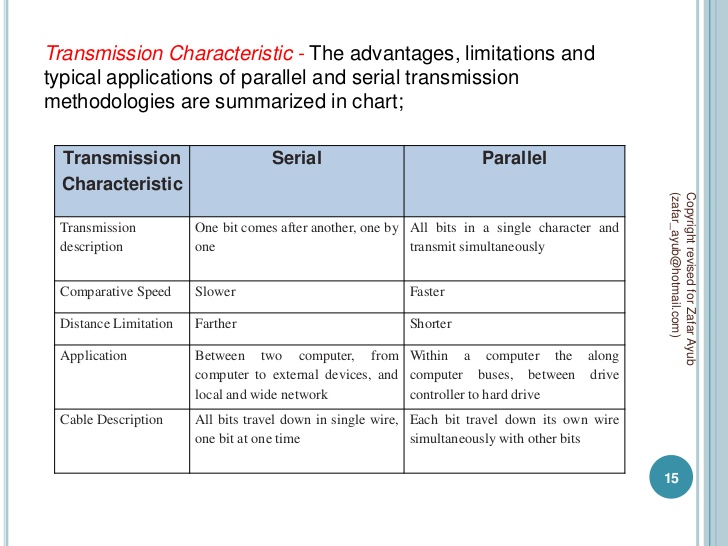

Limited Cable LengthĪs the length of cable increases, so does the amount of metal wires. Therefore, the more is the parallel path, the higher is the achieved data transfer speed. The data exchange speed of a parallel communication data link is equivalent to the multiplication of the number of parallel paths and the number of bits processed at a unit time.
#Advantages of parallel data transmission serial#
Characteristics of Parallel Communicationīefore the development of high speed serial communication technologies, the selection of parallel links against serial communication links was decided by following characteristics: High Speed Data transfer An example of this is distortion/ skipping in internet calls (VOIP) and video streaming. 4 – Parallel Communication – Data Flow through Parallel PathsĪs many bits are transferred over various parallel paths at the same time, the order of received bit strings may be different or out of sync subject to various factors such as source distance, location and available bandwidth. The clock provides the timing for transmission as a constant clocking signal through the parallel paths.įig. In parallel communication, many bits (normally 8 bits or multiples of it) are transferred at the same time on various parallel paths (wires) within the same cable in synchronization with a single clock. EPP remarkably increased the speed of parallel ports from 150 kbps to 2 mbps. This protocol uses the data cycles more effectively and provides data transfer in real time. The Parallel ports became more advanced with the introduction of Enhanced Parallel Port (EPP) protocol. 3 – Comparison between SPP and EPP in Parallel Communication Its introduction nullified various drawbacks of initial parallel ports such as ensuring data integrity and communication supportability up to 30 feet.įig. IEEE 1284 standardizes the physical interfaces to ensure better inter-operable conditions for parallel interfaces. To overcome these downsides, a standard IEEE 1284 was introduced for parallel communication. It still had various downsides such as lack of standardization in physical interfaces and limited distance (six feet) supportability. In spite of these upgradations, parallel data communication was yet to make a mark as a suitable high speed data port. On realization of various benefits of bi-directional communication, IBM made some upgradations and brought a parallel port that supported both ways data transfer. A number of wires in the parallel port were left unused, which could have been utilized for indicating the status of printer. The downside was that it was only providing one directional communication i.e. However, there was a major downside in this Standard Parallel Port (SPP). It was introduced as a fast interface replacement for Dot Matrix printers.

It all started with the introduction of an 8 bit parallel port (also known as Standard Parallel Port) by IBM in 1981. Evolution History of Parallel Communication

The decreasing cost of integrated circuits and the increasing consumer demand for more data exchange speed has made it a suitable choice over Serial links. Printers, RAM, ISA, ATA, SCSI, PCI, Front side bus ,etc., use parallel data transmission.įig. Nevertheless, it is considered to be a swift mode of transfer. This mode of communication is expensive since it requires additional cables and hardware. In contrast to serial transmission, Parallel data transfer uses more than one wire (and that is excluding the ground wire). The basic difference between a parallel and a serial channel is its quantity of various wires in the physical form that is used for transmission of data between different devices. 1 – Introduction to Parallel Communication This is possible using multiple channels for data transfer between transmitter and receiver.įig. In parallel mode of transfer, there is a onetime transfer of data from source to destination. It comprises of several wired channels in parallel. Parallel communication is a method of sending several data signals simultaneously over a transmission link at one time. This post entails Parallel Communication, evolution history, how it works, characteristics, When to use it and difference in Serial & Parallel Communication. Parallel Communication has been a popular choice when a high speed data transfer is required.


 0 kommentar(er)
0 kommentar(er)
